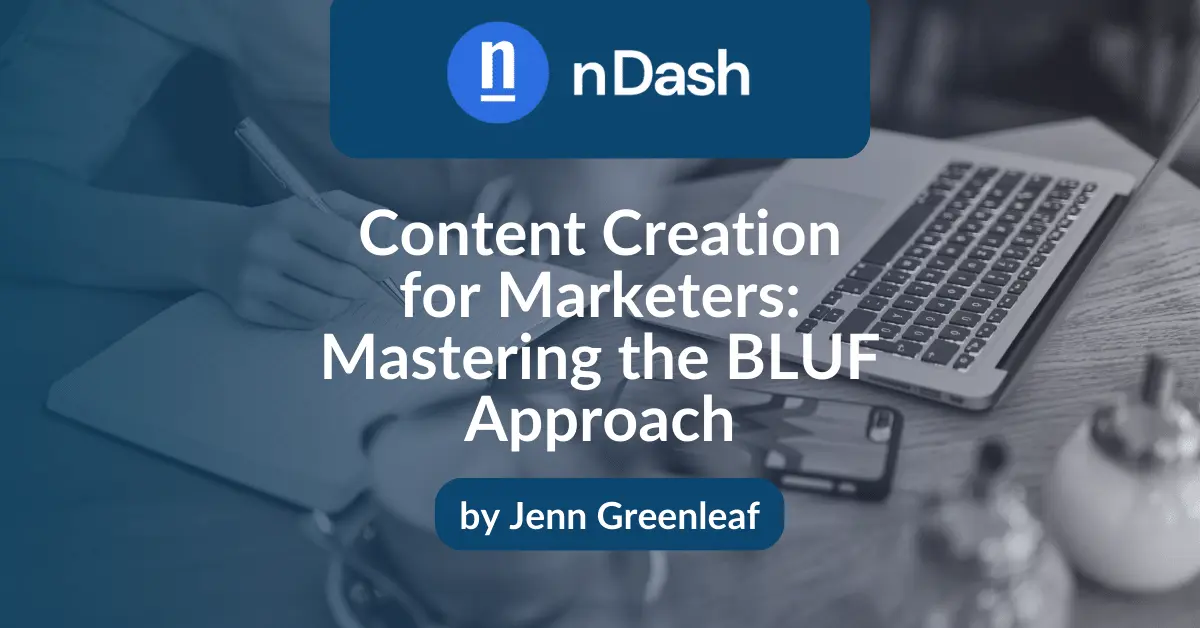Elevate your content creation skills by mastering BLUF, a concise communication technique that ensures your message resonates instantly and effectively.
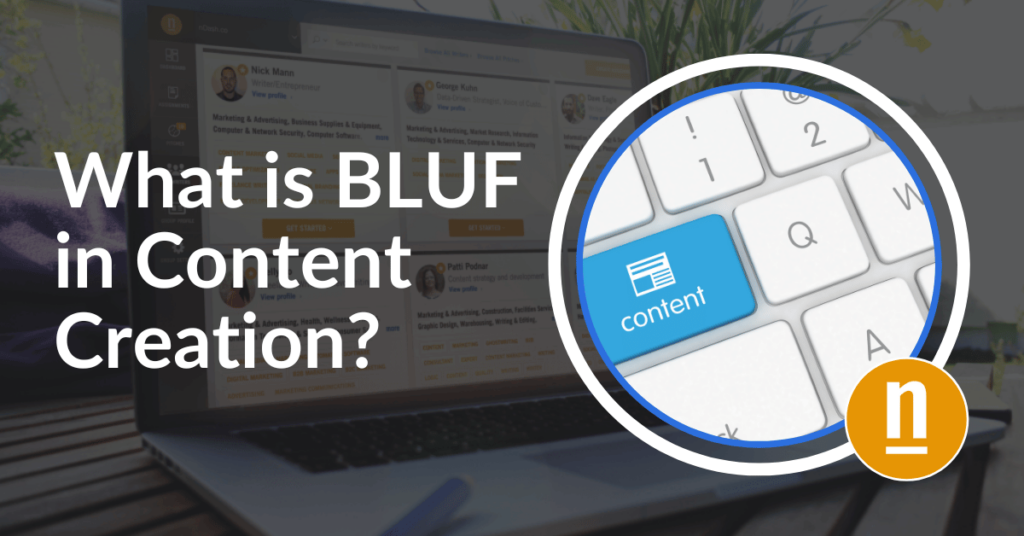
What is BLUF in Content Creation?
Think of a busy executive scrolling through a report. They need more time to sift through pages of data. They need the main point upfront. That’s BLUF in action: it prioritizes presenting the most critical information or conclusion at the beginning of the content.
A study by Nielsen Norman Group found that 70% of people who read online content only scan it. It’s not just about making the main point known in the first few lines or paragraphs. Organizing the entire piece to support and elaborate on that central point clearly and concisely is also essential.
→ Download our BLUF Implementation Checklist for Content Creation here.

Why BLUF in Content Creation is Important for Marketers to Know
Understanding and implementing this strategy in content creation is a game-changer for marketing managers. This approach not only aligns with current consumer behaviors but also enhances the efficacy of your marketing efforts.
Here’s a breakdown of why adopting this strategy is vital in content marketing:
- Improved user experience: Consumers often need help with information. This approach respects the audience’s time by providing the essential information first. This strategy improves the overall user experience and increases the likelihood of the message being well-received.
- Effective communication: Short attention spans require content that gets to the point quickly. BLUF caters to this trend, making content more mobile-friendly.
- Enhanced decision-making: In marketing, the goal is often to prompt an action or decision. Marketers can more effectively guide their audience by stating the bottom line upfront. This approach directs them toward the desired action, whether a purchase, a subscription, or engagement.
- Better content structuring: It encourages marketers to organize their content more effectively, ensuring that the most important information takes precedence. That leads to better-structured and more impactful content.
- Increases content accessibility: For those with limited time, BLUF ensures they can still grasp the main message without reading the entire content. This brevity increases the accessibility and reach of the content.
- Aligns with SEO practices: In digital marketing, especially SEO, placing the main keywords and messages at the beginning of content is beneficial. This approach can improve search engine rankings, as search engines often give more weight to the initial part of the content.
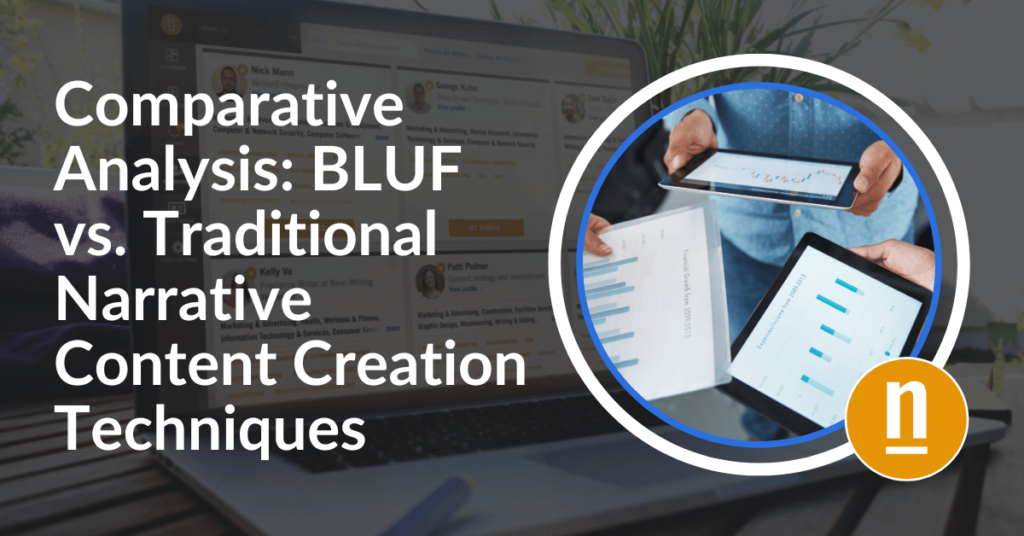
Comparative Analysis: BLUF vs. Traditional Narrative Content Creation Techniques
Below, we highlight how BLUF and traditional narratives differ in their approach and effectiveness based on context and purpose. We also explore how these techniques impact user engagement, SEO, and adaptability to different content creation types.
Business Reports and Proposals (BLUF Approach)
- Example: A business proposal often starts with a BLUF statement. An example of such a statement is, “This proposal outlines a cost-effective solution to increase our quarterly sales by 20%.” It immediately informs the reader of the proposal’s purpose and potential impact.
- Effectiveness: In business settings, where time is often limited, this approach ensures you communicate the key message upfront, facilitating quicker decision-making.
Storytelling in Branding (Traditional Narrative)
- Example: A brand story might begin with a narrative about the company’s beginnings and gradually build up to its current success.
- Effectiveness: This approach emotionally engages the audience and helps build brand loyalty. It’s effective for long-form content where engagement and emotional connection are priorities.
Academic Writing and Research (Traditional Narrative)
- Example: Research papers often start with a background study and methodological approach and then lead to the findings and conclusions.
- Effectiveness: This detailed approach is crucial in academic settings, where thorough examination and buildup of information validate the research.
Sales Pitches and Marketing Emails (BLUF Approach)
- Example: A sales email might start like this, “Our new product guarantees a 50% reduction in energy costs for your home.”
- Effectiveness: Immediately grabbing the reader’s attention is vital. BLUF immediately highlights the main selling point, potentially leading to quicker customer interest and action.
Personal Blogs and Reflective Writing (Traditional Narrative)
- Example: A travel blog might start by setting the scene of a journey before delving into the details of the experiences.
- Effectiveness: For personal blogs, storytelling enriches the reader’s experience, making the content more engaging and memorable.
Emergency Communications (BLUF Approach)
- Example: In an emergency, communications should be direct and clear, like, “Evacuate immediately due to a gas leak in the area.”
- Effectiveness: In urgent situations, clarity and immediacy are critical. BLUF ensures that you communicate essential information without delay.
Literary Works and Novels (Traditional Narrative)
- Example: Novels typically start by setting the scene or introducing characters, gradually building up to the plot.
- Effectiveness: This method suits literary works where the gradual plot and character development build-up is crucial for reader engagement.
Product Descriptions and Listings (BLUF Approach)
- Example: A product listing might begin with, “This smartphone features the longest battery life in its class.”
- Effectiveness: For product descriptions, primarily online, it’s important to quickly communicate the key selling points to capture the buyer’s interest.
Ultimately, whether to use BLUF or a traditional narrative technique depends on several factors. These include the audience, the purpose, the content creation strategy, and the context of the communication.

SEO Implications of BLUF in Digital Content Creation
BLUF improves the user experience by delivering immediate, valuable insights. This approach aligns seamlessly with modern search engine algorithms, prioritizing content creation that swiftly and effectively presents crucial information.
Immediate Relevance in Search Results
By placing the most critical information at the beginning of the content, BLUF ensures clarity. This approach also means that search engine snippets are more likely to contain the core message. For example, a blog post on sustainable living might start with a clear statement about its main topic. This approach immediately makes it clear in search listings.
Enhanced Keyword Prominence
BLUF encourages the early placement of primary keywords, often prioritized by search engines, improving the content’s visibility. For instance, an article about healthy eating can start with a sentence incorporating key phrases like ‘healthy eating.’
Improving User Engagement Metrics
BLUF-style content creation positively influences user engagement metrics like dwell time and bounce rate, as users find relevant information quickly. This influence can lead to better search rankings, as these metrics indicate content quality.
Voice Search Optimization
With the rise of voice search, BLUF’s concise and direct answers align well with voice search queries. Content structured this way will more likely meet users’ needs when performing voice searches.
Aligning with Featured Snippets and Answer Boxes
Content with key information at the start is ideal for snippets and answer boxes in search results. A clear and concise starting point can significantly enhance the chances of being selected for these featured positions.
Content Clarity and Readability
BLUF encourages clear, concise language and well-structured content. This structuring improves readability and is favored by search engines, making the content more SEO-friendly.
Link Building and Content Sharing
Clear and concise content will likely be shared and linked to, enhancing its SEO value. Content that gets straight to the point is attractive for other websites to link to. These links enhance its authority and search ranking potential.
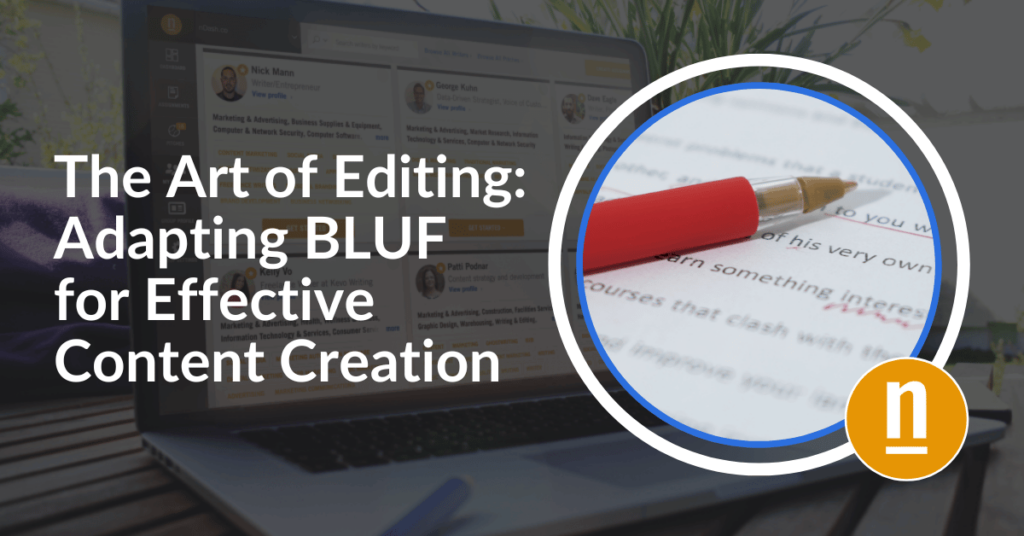
The Art of Editing: Adapting BLUF for Effective Content Creation
The magic of crafting BLUF-compliant content lies in editing. Like sculpting, it transforms raw thoughts into impactful pieces. This section will help you navigate this process, ensuring your content aligns with these principles and resonates with your audience.
- Identify the core message: Determine your content’s primary message or objective. What is the essential point you want your audience to take away? This answer becomes the ‘bottom line’ that guides your editing process.
- Reorganize for clarity: Structure your content so that this core message is prominent. Rearrange paragraphs and sections to ensure that the most critical information takes precedence.
- Trim the excess: This approach is about brevity and directness. Eliminate any information that doesn’t directly contribute to your core message. That includes cutting redundant phrases, removing off-topic tangents, and simplifying complex language.
- Enhance readability: Focus on making your content reader-friendly. Meaning, short paragraphs, clear headings, and bullet points where appropriate. The goal is to make the key points stand out and be easily digestible.
- Strengthen your opening: Begin your piece with engaging opening lines to convey its value to the reader immediately.
- Conclude effectively: Your conclusion should reinforce your main message. Summarize the key points and, if applicable, provide a call to action or a thought-provoking closing thought.
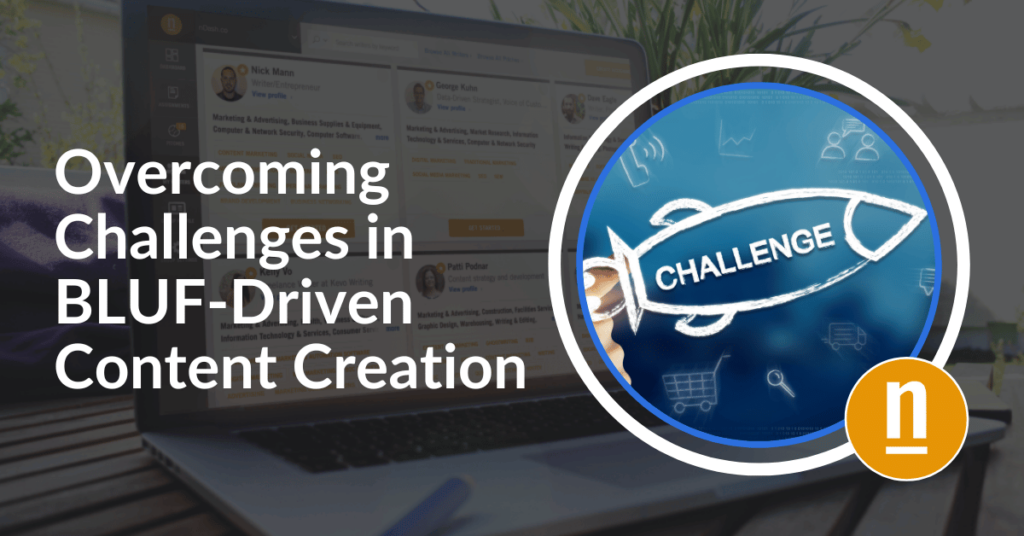
Overcoming Challenges in BLUF-Driven Content Creation
Editing to BLUF principles presents challenges that require thoughtful solutions. This section explores common hurdles and offers strategies to overcome them. These insights will equip you to refine your content while adhering to BLUF, ensuring your message is concise and compelling.
1st Challenge: Over-attachment to Original Writing
- Problem: Freelance writers often need help to cut content they’ve spent considerable time creating, leading to unnecessarily lengthy and unfocused pieces.
- Solutions:
- Distance yourself: Take a break after writing, then return with a fresh perspective.
- Seek external feedback: Ask colleagues or friends to review and suggest cuts. External perspectives can highlight non-essential parts more objectively.
- Use word count limit goals: Set strict word count limits for sections or the entire piece to force conciseness.
2nd Challenge: Maintaining a Personal Touch
- Problem: Regarding brevity, there’s a risk of stripping away the writer’s unique voice, making the content feel impersonal.
- Solutions:
- Blend styles: Mix BLUF with narrative elements where appropriate, such as adding a brief personal story or example after the BLUF statement.
- Voice consistency: Keep your unique voice consistent in the BLUF statement and the rest of the content.
- Selective detailing: Choose one or two details that add personality without detracting from the conciseness.
3rd Challenge: Balancing Depth with Brevity
- Problem: Finding the right balance between being concise and providing enough information can take time and effort.
- Solutions:
- Key point emphasis: Focus on a few key points and elaborate on them briefly.
- Use lists and bullets: Break down complex ideas into lists or bullet points for clarity without excessive wordiness.
- Progressive disclosure: Start with the most critical information and gradually reveal more details for readers interested in diving deeper.
4th Challenge: Ensuring Readability and Engagement
- Problem: Ensuring that BLUF content remains engaging and easy to read can be a delicate balancing act.
- Solutions:
- Use subheadings: Break the text into sections with descriptive subheadings to guide the reader.
- Incorporate visual elements: Use images, charts, or graphs to illustrate points and add visual interest.
- Vary sentence structure: Mix short and longer sentences to maintain rhythm and engagement.
5th Challenge: Aligning with SEO Best Practices
- Problem: Optimizing BLUF content for search engines.
- Solutions:
- Keyword integration: Incorporate relevant keywords in the BLUF statement and throughout the content.
- Meta descriptions: Write meta descriptions that reflect the BLUF approach, briefly capturing the content’s essence.
- Mobile-friendly formatting: Ensure the content is easily readable on mobile devices, with short paragraphs and a straightforward layout.
By addressing these challenges with specific and actionable solutions, the editing process can be more effectively aligned with BLUF principles, ensuring that the final content is concise, clear, and impactful. This approach enhances readability and aligns with the best content creation and SEO practices.

Practical BLUF Examples in Content Creation
This section offers practical examples from internal communications, email strategies, and content marketing. The goal is to provide a roadmap for applying BLUF to enhance clarity, efficiency, and impact.
Internal Communication
- Meeting agendas: Start with the primary goal. For instance, “The main objective of today’s meeting is to finalize the Q1 marketing strategy.”
- Project updates: Begin with the most critical update, like, “Project X is ahead of schedule, and I’ll deliver it by next week.”
Emails
- Client communication: Start with the key message. Example: “We have updated the campaign strategy to increase ROI by 30%.”
- Team updates: Clearly state the main update or request first. E.g., “Please provide feedback on the draft report by EOD Thursday.”
Content Marketing
- Blog posts: Lead with the central idea or finding. Example: “The latest research shows a 25% increase in remote work productivity.”
Social media posts: Get straight to the point. For example, “Our new product line launches today, offering advanced features at competitive prices.”
Academic Writing
- Research abstracts: Begin with the main conclusion or discovery. For instance, “This study identifies a novel approach to improving solar panel efficiency.”
- Policy briefs: Start with the key recommendation. Example: “We recommend taking immediate action to address the urban housing shortage.”
Reports and Proposals
- Business reports: Lead with the most significant finding. E.g., “This quarter’s revenue exceeded targets by 15%.”
- Grant proposals: Start with the primary purpose. Example: “This proposal seeks funding to support youth STEM education in underserved communities.”
Advertising and Sales
- Product descriptions: Begin with the most compelling feature. E.g., “This smartphone’s camera outperforms competitors in low-light conditions.”
- Sales pitches: Start with the primary value proposition. Example: “Our service guarantees a 50% reduction in operational costs.”
Technical Documentation
- User manuals: Start with the most crucial instruction or tip. For example, “To ensure your safety, read these operating instructions fully before use.”
- FAQ sections: Lead with the most critical information. E.g., “You can resolve most issues by resetting the device.”
Remember, first drafts should be exploratory. The revision process is an opportunity to transform that exploration into a clear and concise message for your readers.
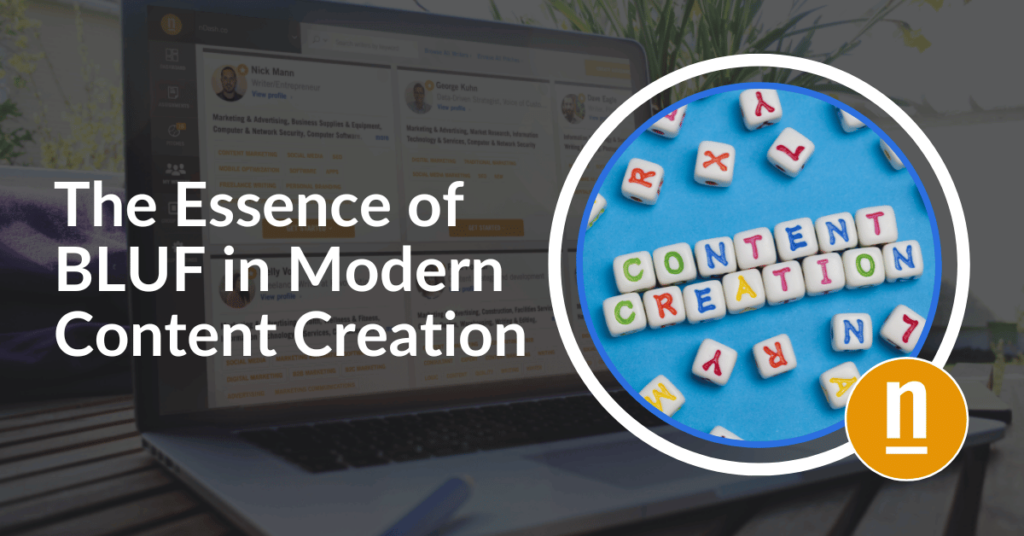
The Essence of BLUF in Modern Content Creation
Every word counts when creating content for audiences beyond just friends or family. To ensure your message connects more effectively, structure your content to deliver it promptly and provide all necessary context. Contact us today to discover how our talent pool of elite freelance writers can help you achieve your content creation goals.
